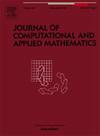A new subspace iteration algorithm for solving generalized eigenvalue problems in vibration analysis
IF 2.1
2区 数学
Q1 MATHEMATICS, APPLIED
Journal of Computational and Applied Mathematics
Pub Date : 2025-03-14
DOI:10.1016/j.cam.2025.116622
引用次数: 0
Abstract
Large scale generalized eigenvalue problems (GEP) arise in many applications, such as the vibration analysis, quantum mechanics, electronic structure calculation. A class of subspace iteration method, the generalized Chebyshev–Davidson (gCD) algorithm, was recently proposed to solve GEP. In the gCD algorithm, the Chebyshev polynomial filter technique is incorporated in the subspace iteration. One of the advantages of the gCD algorithm is that it only concerns matrix vector product, making it suitable for solving large-scale problems. In this paper, based on gCD algorithm, a new subspace iteration algorithm is constructed. In the proposed algorithm, we combine the Chebyshev filter and inexact Rayleigh quotient iteration techniques to enlarge the subspace in the iteration, and the obtained algorithm is named as Chebyshev-RQI subspace (CRS) method. Numerical results for both two dimensional and three dimensional vibration analysis problems show that CRS algorithm is more effective than gCD algorithm measured by iteration numbers and computing time. Specifically, when these two methods are used to compute the smallest 20 eigenpairs of the tested vibration models, CRS converges at least 3.9 times faster than gCD measured by number of iteration and up to 2.5 times faster than gCD measured by solution time. Furthermore, CRS algorithm is more robust than gCD because in some cases, gCD cannot converge while CRS always converges for all test cases.
求解振动分析中广义特征值问题的一种新的子空间迭代算法
大规模广义特征值问题在振动分析、量子力学、电子结构计算等领域有着广泛的应用。最近提出了一类求解GEP的子空间迭代方法——广义chebyhev - davidson (gCD)算法。在gCD算法中,子空间迭代中加入了切比雪夫多项式滤波技术。gCD算法的优点之一是它只涉及矩阵向量积,适合于求解大规模问题。在gCD算法的基础上,构造了一种新的子空间迭代算法。在该算法中,我们结合Chebyshev滤波和非精确瑞利商迭代技术来扩大迭代中的子空间,并将得到的算法命名为Chebyshev- rqi子空间(CRS)方法。对二维和三维振动分析问题的数值结果表明,从迭代次数和计算时间来看,CRS算法比gCD算法更有效。具体而言,当使用这两种方法计算测试振动模型的最小20个特征对时,CRS的收敛速度比以迭代次数测量的gCD至少快3.9倍,比以求解时间测量的gCD快2.5倍。此外,CRS算法比gCD算法更健壮,因为在某些情况下,gCD不能收敛,而CRS算法对所有测试用例都是收敛的。
本文章由计算机程序翻译,如有差异,请以英文原文为准。
求助全文
约1分钟内获得全文
求助全文
来源期刊
CiteScore
5.40
自引率
4.20%
发文量
437
审稿时长
3.0 months
期刊介绍:
The Journal of Computational and Applied Mathematics publishes original papers of high scientific value in all areas of computational and applied mathematics. The main interest of the Journal is in papers that describe and analyze new computational techniques for solving scientific or engineering problems. Also the improved analysis, including the effectiveness and applicability, of existing methods and algorithms is of importance. The computational efficiency (e.g. the convergence, stability, accuracy, ...) should be proved and illustrated by nontrivial numerical examples. Papers describing only variants of existing methods, without adding significant new computational properties are not of interest.
The audience consists of: applied mathematicians, numerical analysts, computational scientists and engineers.

 求助内容:
求助内容: 应助结果提醒方式:
应助结果提醒方式:


